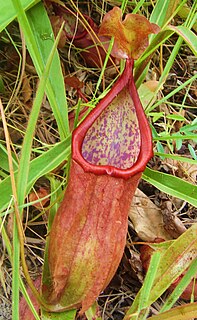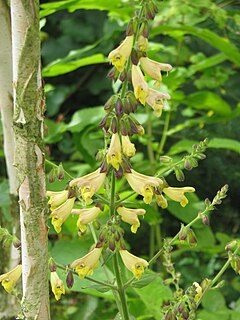
Nepenthes suratensis is a tropical pitcher plant endemic to Surat Thani Province, Thailand, where it grows near sea level in coastal savannah and grassland. It is thought to be most closely related to N. andamana.

Salvia dolichantha is a herbaceous perennial native to Sichuan province in China, growing at 3,700 m (12,100 ft) elevation. It grows up to 80 cm (31 in) high, with purple flowers that are approximately 5 cm (2.0 in) long. The leaves are cordate-ovate to hastate-ovate, 6.5 to 9 cm long and 5.5 to 9 cm wide.
Salvia wardii is a perennial plant that is native to Tibet, found growing in alpine grasslands and thickets at 3,600 to 4,500 m elevation. It grows 50 to 75 cm high, on strong stems that are glandular and hairy, forming into a thick spreading plant. It has many basal leaves that are ovate to subhastate, 7 to 16 cm long and 3.5 to 8 cm wide. The upper leaf is slightly ridged with short hairs, the underside has red glandular hairs, especially dense on the veins.
Salvia himmelbaurii is a perennial plant that is found growing on grassy slopes at 3,300 m (10,800 ft) elevation in Sichuan province in China. It grows 30 to 45 cm tall, with cordate-ovate leaves that are 5 to 10 cm long and 3.5 to 7.5 cm wide. The upper leaf surface is covered with soft hairs, with the underside having hairs especially on the veins.
Salvia maximowicziana is a perennial plant that is found growing on grasslands, forests, and forest edges in China, at 1,800 to 3,300 m elevation. It grows 10 to 90 cm tall, with circular-cordate to ovate-cordate leaves that are typically 3 to 8 cm long and 6 to 8 cm wide. The upper leaf surface is nearly smooth, or lightly covered with hairs, while the underside has glandular hairs on the veins.
Salvia cynica is a perennial plant that is native to Sichuan province in China, growing in forests and streamsides at 1,500 to 3,200 m elevation. The leaves are broadly ovate to broadly hastate-ovate or subcircular, ranging in size from 5 to 20 cm long and 3 to 18 cm wide.

Salvia omeiana is a perennial plant that is native to forest edges and hillsides in Sichuan province in China, growing at 1,400 to 3,100 m elevation. It is a robust erect-growing plant reaching .4 to 1 m, with broad cordate-ovate to hastate-ovate leaves that are 10 to 16 cm long and 6.5 to 14.5 cm wide. Inflorescences are raceme-panicles, with a 2.5 to 3.5 cm yellow corolla.
Salvia alatipetiolata is a perennial plant that is native to Sichuan province in China, growing on grassy hillsides at 3,800 m (12,500 ft) elevation. The plant grows on erect stems up to 40 cm (16 in) tall, with numerous basal leaves that are ovate-hastate, ranging in size from 3.5 to 6 cm long and 1.5 to 4.5 cm wide. The upper leaf surface is mostly smooth, while the underside has many gray hairs.
Salvia evansiana is a perennial plant that is native to Sichuan and Yunnan provinces in China, found growing on alpine meadows, hillsides, and forests at elevations from 3,400 to 4,300 m. It has erect stems growing 13 to 45 cm tall, with ovate to triangular-ovate leaves that are 2 to 11 cm long and 1 to 11 cm wide.
Salvia pauciflora is a perennial plant that is native to Yunnan province in China, growing in and around forests at 2,800 to 3,400 m elevation. It grows on 2-4 slender unbranched stems with widely spaced leaves. The leaves are broadly ovate to ovate-triangular, typically ranging in size from 2.5 to 6 cm long and 1.2 to 5 cm wide.
Salvia schizocalyx is a perennial plant that is native to Yunnan province in China, growing at 4,000 m (13,000 ft) elevation. The plant grows on one to a few unbranched upright stems with widely spaced leaves, reaching approximately 45 cm (18 in) tall. The leaves are broadly ovate to narrowly triangular-ovate, and rarely oblong-ovate, typically ranging in size from 2 to 5 cm long and 1.2 to 4.5 cm wide, though they can grow larger.
Salvia mairei is a perennial plant that is native to Yunnan province in China. The plant grows on one to a few stems from 20 to 40 cm tall. The leaves are cordate-ovate to subhastate-ovate, typically ranging in size from 3.5 to 5 cm long and 1.8 to 5 cm wide, though they are sometimes larger. Inflorescences are 4-flowered verticillasters on terminal racemes or panicles that are 8 to 11 cm long. The corolla is violet or purple, 1.5 to 1.8 cm long.
Salvia campanulata is a perennial plant that is native to Xizang and Yunnan provinces in China, along with locations in Bhutan, India (Sikkim), Myanmar, and Nepal. It is typically found growing at 800 to 3,800 m elevation in and around forests, on hillsides, and in valleys. There are four named varieties.
Salvia hylocharis is a perennial plant that is native to Xizang and Yunnan provinces in China, growing on grassy slopes, forest margins, and streamsides at 2,800 to 4,000 m elevation. S. hylocharis grows on one or two ascending to erect stems to 45 to 90 cm tall. The leaves are ovate-triangular to ovate-hastate, typically ranging in size from 3 to 8.5 cm long and approximately 8.5 cm (3.3 in) wide, though they sometimes are larger.
Salvia smithii is an aromatic perennial plant that is native to Sichuan province in China, found growing on riverbanks, valleys, and hillsides at 2,600 to 3,500 m elevation. S. smithii grows to 30 to 90 cm tall, with leaves that are broadly cordate-ovate to ovate-hastate, ranging in size from 4 to 22 cm long and 3 to 18 cm wide.
Salvia atropurpurea is a perennial plant that is native to Yunnan province in China, growing on grassy slopes at 3,400 m (11,200 ft) elevation. S. atropurpurea grows on one erect stem to 50 cm (20 in) tall. The leaves are ovate to broadly ovate, ranging in size from 3.5 to 10.5 cm long and approximately 2.5 to 9 cm wide.
Salvia atrorubra is a perennial plant that is native to Yunnan province in China, found growing in forests at 2,700 m (8,900 ft) elevation. S. atrorubra grows on erect stems to 55 cm (22 in) tall, with ovate leaves that are typically 6 to 10.5 cm long and 4 to 8 cm wide, sometimes slightly smaller.
Salvia subpalmatinervis is a perennial plant that is native to Yunnan province in China, found growing in thickets, forests, and hilly grasslands at 3,400 to 4,000 m elevation. S. subpalmatinervis grows on one to three erect stems to 50 cm (20 in) tall, with mostly basal leaves that are ovate to circular.
Salvia mekongensis is a perennial plant native to Yunnan province in China, found growing on hilly grasslands at 2,800 to 4,100 m elevation. S. mekongensis grows on one to five ascending to erect stems, with mostly basal leaves that are usually ovate to oblong-ovate, 3 to 9 cm long and 2 to 8 cm wide.

Salvia nipponica is a perennial plant that is native to Japan and Taiwan. Stems grow from 20 to 50 cm, with triangular-ovate to triangular-hastate leaves that are typically 2 to 7 cm by 1.3 to 6 cm. The 2.2 to 2.4 cm flowers have many hairs, with a yellow corolla that has a red spot.





